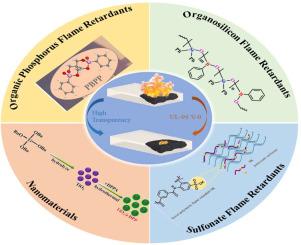Making polycarbonate flame retardant and transparent: Current advances and future challenges in flame retardant selection and mechanisms
IF 7.4
2区 化学
Q1 POLYMER SCIENCE
引用次数: 0
Abstract
Polycarbonate (PC) is the only thermoplastic engineering plastic among general engineering plastics that possesses excellent transparency (> 90 %) and inherent flame retardancy (UL-94 V-2 rating). However, in the field of photoelectric safety engineering applications, achieving a UL-94 V-0 rating without compromising transparency remains a critical challenge. Conventional flame-retardant additives often suffer from inefficiency, high loading requirements, and poor compatibility, leading to significant deterioration of optical properties. Addressing these limitations necessitates the strategic design of additives to enhance flame-retardant efficiency while ensuring compatibility with the PC matrix. This review comprehensively summarizes recent advances in environmentally benign flame-retardant systems for transparent PC, including organic phosphorus, sulfonate, organosilicon, and nanomaterials flame retardants. By elucidating the structure-performance relationships and mechanistic pathways of these additives, this work highlights innovative strategies to optimize flame-retardant performance while preserving optical clarity, further focusing on synergistic approaches, and interfacial compatibility enhancement. Finally, key challenges with current flame retardant system are discussed and some molecular design principles are proposed to guide the development of next-generation transparent PC materials that meet stringent safety and performance standards in optoelectronic and engineering applications.

使聚碳酸酯阻燃和透明:阻燃剂选择和机制的当前进展和未来挑战
聚碳酸酯(PC)是通用工程塑料中唯一具有优异透明度(90%)和固有阻燃性(UL-94 V-2等级)的热塑性工程塑料。然而,在光电安全工程应用领域,在不影响透明度的情况下实现UL-94 V-0等级仍然是一个关键挑战。传统的阻燃添加剂往往存在效率低、负载要求高、相容性差等问题,导致光学性能明显恶化。为了解决这些限制,需要对添加剂进行战略性设计,以提高阻燃效率,同时确保与PC基体的兼容性。本文综述了透明聚氯乙烯环境友好型阻燃体系的最新进展,包括有机磷、磺酸盐、有机硅和纳米材料阻燃剂。通过阐明这些添加剂的结构-性能关系和机理途径,本工作强调了在保持光学清晰度的同时优化阻燃性能的创新策略,进一步关注协同方法和界面相容性增强。最后,讨论了当前阻燃体系面临的主要挑战,并提出了一些分子设计原则,以指导下一代透明PC材料的开发,使其在光电和工程应用中满足严格的安全和性能标准。
本文章由计算机程序翻译,如有差异,请以英文原文为准。
求助全文
约1分钟内获得全文
求助全文
来源期刊

Polymer Degradation and Stability
化学-高分子科学
CiteScore
10.10
自引率
10.20%
发文量
325
审稿时长
23 days
期刊介绍:
Polymer Degradation and Stability deals with the degradation reactions and their control which are a major preoccupation of practitioners of the many and diverse aspects of modern polymer technology.
Deteriorative reactions occur during processing, when polymers are subjected to heat, oxygen and mechanical stress, and during the useful life of the materials when oxygen and sunlight are the most important degradative agencies. In more specialised applications, degradation may be induced by high energy radiation, ozone, atmospheric pollutants, mechanical stress, biological action, hydrolysis and many other influences. The mechanisms of these reactions and stabilisation processes must be understood if the technology and application of polymers are to continue to advance. The reporting of investigations of this kind is therefore a major function of this journal.
However there are also new developments in polymer technology in which degradation processes find positive applications. For example, photodegradable plastics are now available, the recycling of polymeric products will become increasingly important, degradation and combustion studies are involved in the definition of the fire hazards which are associated with polymeric materials and the microelectronics industry is vitally dependent upon polymer degradation in the manufacture of its circuitry. Polymer properties may also be improved by processes like curing and grafting, the chemistry of which can be closely related to that which causes physical deterioration in other circumstances.
 求助内容:
求助内容: 应助结果提醒方式:
应助结果提醒方式:


